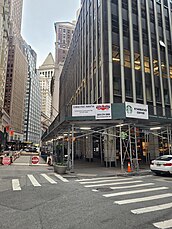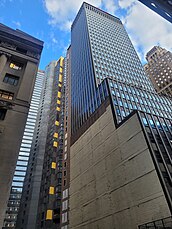
Downtown Los Angeles (DTLA) is the central business district of Los Angeles. It is part of the Central Los Angeles region and covers a 5.84 sq mi (15.1 km2) area. As of 2020, it contains over 500,000 jobs and has a population of roughly 85,000 residents, with an estimated daytime population of over 200,000 people prior to the COVID-19 pandemic. Despite a business exodus from downtown Los Angeles since the COVID-19 pandemic, the district is evolving as a cultural center with the world's largest showcase of architecture designed by Frank Gehry.

Larry A. Silverstein is an American businessman. Among his real estate projects, he is the developer of the rebuilt World Trade Center complex in Lower Manhattan, New York City, as well as one of New York's tallest residential towers at 30 Park Place, where he owns a home.

Downtown Newark is the central business district of Newark in Essex County, in the U.S. state of New Jersey.
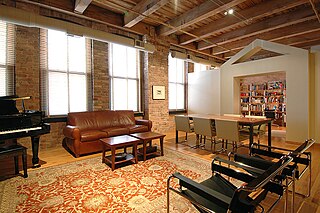
A loft is a building's upper storey or elevated area in a room directly under the roof, or just an attic: a storage space under the roof usually accessed by a ladder. A loft apartment refers to large adaptable open space, often converted for residential use from some other use, often light industrial. Adding to the confusion, some converted lofts themselves include upper open loft areas.

Downtown Louisville is the largest central business district in the Commonwealth of Kentucky and the urban hub of the Louisville, Kentucky Metropolitan Area. Its boundaries are the Ohio River to the north, Hancock Street to the east, York and Jacob Streets to the south, and 9th Street to the west. As of 2015, the population of downtown Louisville was 4,700, although this does not include directly surrounding areas such as Old Louisville, Butchertown, NuLu, and Phoenix Hill.

Downtown Richmond is the central business district of Richmond, Virginia, United States. It is generally defined as being bound by Belvidere Street to the west, I-95 to the north and east, and the James River to the south. The Fan district borders it to the west, Highland Park to the north, Church Hill to the east, and Manchester to the south.
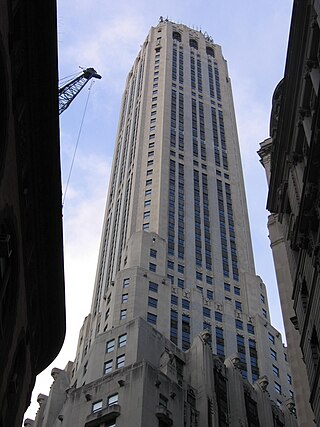
20 Exchange Place, formerly the City Bank–Farmers Trust Building, is a skyscraper in the Financial District of Lower Manhattan in New York City. Completed in 1931, it was designed by Cross & Cross in the Art Deco style as the headquarters of the City Bank–Farmers Trust Company, predecessor of Citigroup. The building, standing at approximately 741 feet (226 m) with 57 usable stories, was one of the city's tallest buildings and the world's tallest stone-clad building at the time of its completion. While 20 Exchange Place was intended to be the world's tallest building at the time of its construction, the Great Depression resulted in the current scaled-back plan.

21 West Street, also known as Le Rivage Apartments, is a 33-story building located in the Financial District of Lower Manhattan in New York City, on Morris Street between West Street and Washington Street. It was built in 1929–1931 as a speculative office tower development in anticipation of an increased demand for office space in Lower Manhattan. The building was converted into apartments in 1997 and was renamed Le Rivage.
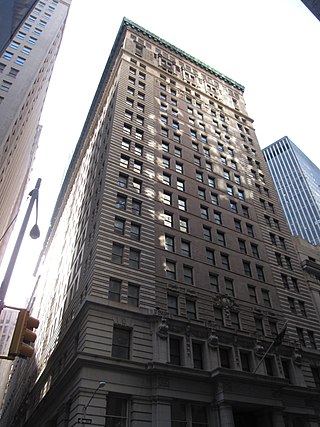
The Broad Exchange Building, also known as 25 Broad Street, is a residential building at Exchange Place and Broad Street in the Financial District of Lower Manhattan in New York City. The 20-story building was designed by Clinton & Russell and built between 1900 and 1902. The Alliance Realty Company developed the Broad Exchange Building as a speculative development for office tenants.

211 North Ervay is a high rise located at 211 North Ervay Street in the City Center District of Dallas, Texas, United States. The building rises 250 feet and contains 18 floors of office space. The colorful building of modernist design is situated on a prominent city corner and adjacent to Thanks-Giving Square.

Corrigan Tower, also known as 1900 Pacific or 1900 Pacific Residences, is a high rise located at 1900 Pacific Avenue in the City Center District of Dallas, Texas. The building contains 20 floors, now made up of apartments but originally office space, and is of modernist design. It is situated on the high-traffic corner of St. Paul Street and Pacific Avenue, across from Aston Park and the future Pacific Plaza Park. It lies within the Harwood Historic District, but is not a contributing structure.
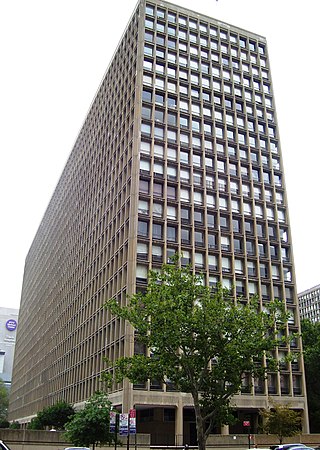
Kips Bay Towers is a 1,118-unit, two-building condominium complex in the Kips Bay neighborhood of Manhattan in New York City. The complex was designed by architects I.M. Pei and S. J. Kessler, with the involvement of James Ingo Freed, in the brutalist style and completed in 1965. Originally known as Kips Bay Plaza, the project was developed by Webb & Knapp as middle-income rental apartments, but was converted to condominiums in the mid-1980s.
CetraRuddy Architecture is a New York City-based architecture and interior design firm with projects in New York City, the United States, Europe, and the Middle East. It provides architectural and interior design services for residences, hotels, schools, and cultural institutions. The firm was founded in 1987 by John Cetra and Nancy J. Ruddy and is led by four principals and three associate principals with a staff of over 100 architects and interior designers.

OliverMcMillan, established in 1978, is a private real estate development firm based in San Diego, California. It creates mixed-use retail, entertainment, and residential projects, both privately and through public-private partnerships with public entities and redevelopment agencies across the U.S. OliverMcMillan has received four national industry design awards and more than 50 regional industry design awards over the past 35 years. The firm has designed and developed more than eight million square feet of projects, with a total project value exceeding $3 billion. As of 2014, OliverMcMillan has approximately $2 billion in real estate projects under development in major U.S. cities, including Houston, San Diego, Honolulu, Atlanta and Phoenix.

287 Broadway is a residential building at the southwest corner of Broadway and Reade Street in the Civic Center and Tribeca neighborhoods of Lower Manhattan in New York City. The six-story, cast iron building was designed by John B. Snook in the French Second Empire and Italianate styles and was completed in 1872. Through the 19th and 20th centuries, it served as an office building before becoming a residential structure. 287 Broadway is a New York City designated landmark and is listed on the National Register of Historic Places.
45 Broad Street is a residential building being constructed in the Financial District of Manhattan in New York City. The building was originally planned as Lower Manhattan's tallest residential tower. Excavation started in 2017, but as of 2020, construction is on hold.
Bulfinch Crossing is a redevelopment project currently under construction in Downtown Boston, Massachusetts, United States. It will consist of two skyscrapers, a smaller residential tower, a low-rise office building, a hotel, and a low-rise retail building. Site preparation began in late 2015, and construction officially commenced on January 24, 2017. Construction on the residential tower completed in 2020. The high-rise office tower, One Congress, commenced construction in 2019 and topped off in July 2021; after an announced plan to open in 2022, it officially opened in September 2023.
The New York City Loft Board is a quasi-legislative and judicial body of the New York City government that oversees the legal conversion of commercial and manufacturing spaces to residential use.

56 Beaver Street is a structure in the Financial District of Manhattan in New York City, United States. Designed by James Brown Lord, the building was completed in 1891 as a location of the Delmonico's restaurant chain. The current building, commissioned by Delmonico's chief executive Charles Crist Delmonico, replaced Delmonico's first building on the site, which had been built in 1837. The building is a New York City designated landmark and a contributing property to the Wall Street Historic District, a National Register of Historic Places district.

25 Water Street, also known as 4 New York Plaza, is a building at Water Street and Broad Street the Financial District of Manhattan in New York City, U.S. It directly adjoins both 125 Broad Street to the south, which is connected, and the Vietnam Veterans Plaza to the east. The building was completed in 1969 and operated as an office building from 1969 to 2022. As of 2023 it is being redeveloped into a residential building that is planned to have over 1,300 apartments, which would make it the largest office-to-residential property conversion in the United States.



